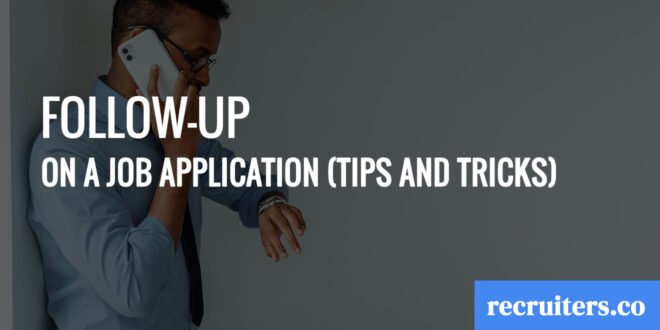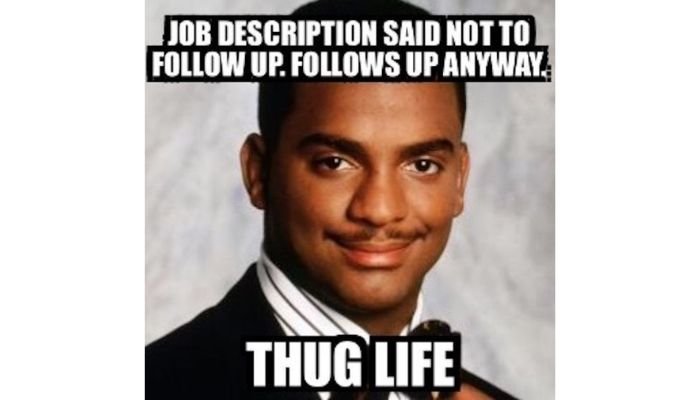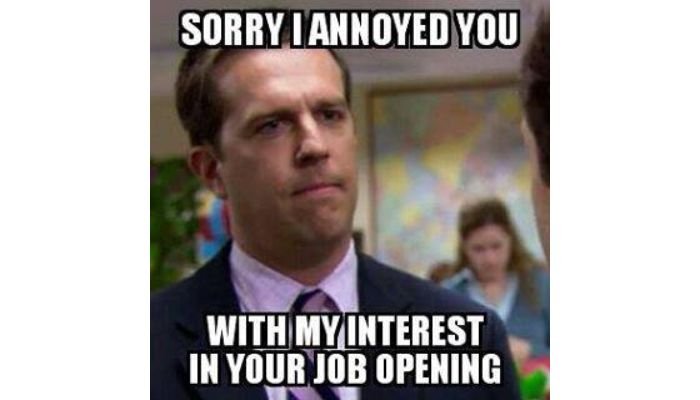Follow-up on a Job Application (Tips and Tricks)

The job search experience is crucial and often determines a person’s career success. It can be a frustrating process, but carefully crafted follow-up strategies are an important behavior critical to the landing of your desired job. No longer is it almost exclusively enough to submit just one application to employers.
Therefore this guide seeks to explain clever tactics by teaching prospective applicants effective techniques for executing successful job application follow-ups which prove essential during this journey.
Providing knowledge about finding specific details online is necessary for staying current with an organization as well as starting to highlight remarkable qualities on paper, holding onto gracious attitude even after a disagreement and also eventually emerging victoriously after numerous tries is what defines a winning run before reaching steady podium of employment across industries.
Pre-Follow-Up Preparation
Review the application timeline

Reviewing the application timeline before initiating follow-up activities is a critical step that sets you up for success. A good understanding of when and how to follow-up depends on the response timeline stated in the company’s recruitment advertisement.
Every job recruiting comes with an update featuring anticipated time frames hour feedback that can be expected from the employer, terms, and conditions associated with providing interview opportunities as well as response status every applicant should look forward in order.
To make sure nobody gets left behind, start alert stages should also focus on noticing if expiration dates have lapsed or announcements potentially removed afterward for firms taking longer investments.
Understand the company’s preferred communication method
When following up on a job application, it is important to understand the company’s communication preferences before reaching out.
Depending on the size of the organization, they may prefer one method over another—for example, many businesses will list an email address specifically for recruitment purposes but some may value phone calls more than emails. To best respect their process and business procedures, take into consideration which medium they stipulate for addressing new recruits or vacancies and compose your message accordingly.
Familiarize yourself with other methods if possible in case you ever make contact directly and need another way to follow-up. Done properly, customers are more likely to receive information quickly and respond in a timely manner–simple requirements that are sure to yield greater results.
Gather necessary information

1. Job posting details
Job posting details will provide potential applicants with an understanding of descriptive details, salary requirements as well as hiring criteria indicated by a company’s job advertisement.
By thoroughly reading through the entire job description, interested candidates can derive valuable insight into both personal traits required for someone who would thrive in such role, and established expectations from employment prospects. This information can then be distilled to shape unique follow-up messages that pertain specifically to one role being discussed.
2. Contact information of relevant personnel
Gathering the right contact information for your job application follow-up is essential to ensure the employer receives it. Contacting a company’s recruitment team or coordinators often provides the fastest path to success and will allow you to establish a rapport early on in the process. Determining which personnel within an organization handles candidate inquiries can also prove immensely valuable when starting your outreach attempts.
Crafting a Professional Follow-Up Message
1. Choose an appropriate medium (email, phone call, or letter)
Crafting a professional follow-up message that highlights your strongest qualifications and expresses enthusiasm about the position is an important step in the job application process.
Depending on preference, it’s typically best to either choose an email, phone call or a formal letter for communication; however, understanding what type of business setting the hiring party operates in may restrict content length for certain available options (ie. emails and phone calls are better as shorter messages).
2. Express gratitude and enthusiasm
Expressing gratitude and enthusiasm when following up on a job application certainly shows the employer that you care about their company; Is eager to hear back, and have taken the time to put together a detailed thought-out message. You should start by thanking them for taking the time to consider your application, followed by immediately expressing your continued interest in pursuing the opportunity. Just remember that you should not come off too strong in reminding them about the said opportunity.
3. Address any additional information requested
When composing a professional follow-up message, be sure to address any additional information requested. Consider mentioning relevant projects, skill certifications, or qualifications that weren’t covered in the initial application. Provide concrete evidence to demonstrate your suitability and interest for the position.
Include an up-to-date CV or portfolio that showcases any new work experience, successes, or awards garnered since submitting the application. By making a good impression with tailored information after the initial application submission, you increase your chances of standing above the crowd.
In-Person Follow-Up

Appropriate situations for an in-person follow-up
An in-person follow up is most effective when the job requires strong networking and interpersonal skills, or if the connection between yourself and employees of the desired organization has been previously established.
The goal should be to contact someone internally prior to physically visiting the place—who can potentially connect with you on a deeper level or speed up your application process.
Dressing professionally for the visit
Formal or business attire is appropriate in most job application follow-ups unless explicitly stated by company protocol. It’s also essential to maintain hygiene such as making sure hair is neatly combed and any makeup used for females should be minimal yet polished and professional.
Pay particular attention to details such as polish knee-high boots or dress shoes that are presentable and fit well with clothes, and accessories ( watch, briefcase ) in an effort to make overall an impressive front. It might be wise to wear “black suit” reflecting younger audience’s look for many.
Communicating confidently and effectively during the meeting
Throughout a meeting, it is important to remember the foundation of polite practice while communicating confidently and with purpose.
Speak clearly, pause between words to emphasize key points or express understanding/agreement by nodding at questions being asked. Maintaining eye contact without getting overly pleased or seemingly bored is entwined yet extremely important.
Following Up After an Interview
Expressing gratitude for the interview opportunity
Following up after an interview starts with expressing gratitude for the invitation. It shows employers that applicants recognize their generous time and giving nature, which may make a great impression overall.
Expressing appreciation should also be sincere; ensuring heartfelt sentiments make a longer-lasting impact on employers. Subsequent remarks can include assurance of fuel-continuing reciprocation throughout future endeavors in the application process.
Mentioning key points discussed during the interview
The key to effective job interview follow-up is to remain professional and maintain a positive attitude. This can be achieved by writing or saying thank you immediately after the interview and jotting down important points discussed throughout the exchange.
It’s also crucial to restate your enthusiasm toward the role, its responsibilities, and personal growth opportunities while referring back to key conversation points impeccably picked up during the dialogue. Recap on points such as specific answers which another team member was impressed of as well as additional knowledge unknown pertinent that went into explaining why your candidacy was perfectly suitable for this position.
Following Up on Online Job Applications
Checking the application status on the company’s website
Once a job seeker submits an online application, it is important to follow up. The first step in the process is typically checking the company’s website for updates or notifications regarding your application status.
Visiting the site daily to check if they have responded can help to indicate their responsiveness and provide peace of mind. For those who do not receive a response, it may be appropriate to proceed with additional follow-up measures as any extraneous effort demonstrates genuine enthusiasm for the position.
Networking with employees or contacts within the organization
Networking with colleagues or contacts in the same industry playing a key role when applying for online jobs, guaranteeing more accurate answers through communication. An increase and leveraging of opportunities is possible by utilizing an immediate network because the information shared locally equates to relationships formed intentionally.
Handling Rejection and Moving Forward

Responding professionally to rejection notifications
When responding to rejection notifications it’s important to remain professional and courteous. Follow basic courtesy, thank them for their time, and avoid overstaying your welcome even if it wasn’t what you were hoping for. Consider asking to recollect valuable points of feedback that could help carry forward with future applications.
Requesting feedback for future improvement
Requesting feedback is an essential step in handling job application rejection. Although it can feel disheartening to anticipate getting constructive criticism, the answers you receive could very well be your best chance at determining where improvements can be made for future applications.
Sending a polite yet sincere email to inquire on the reasons you didn’t advance any further and inviting dialogue are both suitable ways in which you can make such requests; follow-up power moves, when done tastefully, may help you add shared impressions resonating beforehand to personal experience following decline letters.
Conclusion
In conclusion, job application follow-up should involve preparation, targeted messaging, appropriate timing/frequency, and channels of communication. As important as it is to Dressing professionally and speaking clearly and confidently in person or on the phone will help make a good impression.
Following up respectfully even after rejection can also continue to build positive associations – creating opportunities for future consideration. Job seekers need to approach their applications and follow-ups persistently but professionally in order to showcase their talents and commitment to any potential employers. So don’t be reluctant—continue to proactively stand out from other applicants through responsible follow-up techniques!
- Mastering Internal Mobility: A Comprehensive Guide to Success - August 10, 2023
- Effective Recruiting Strategies in a Competitive Sales Labor Market - July 27, 2023
- 6 Essential Factors to Attract Top Talent - July 19, 2023
